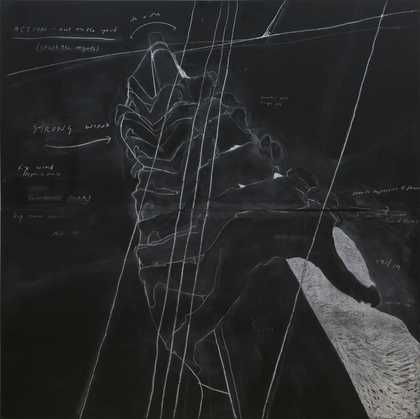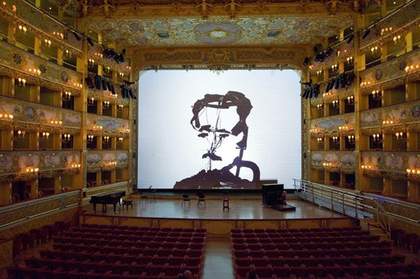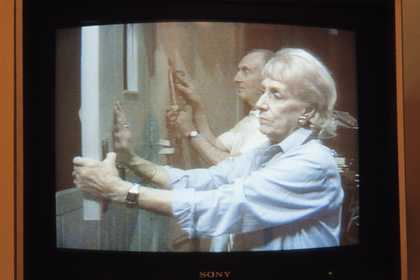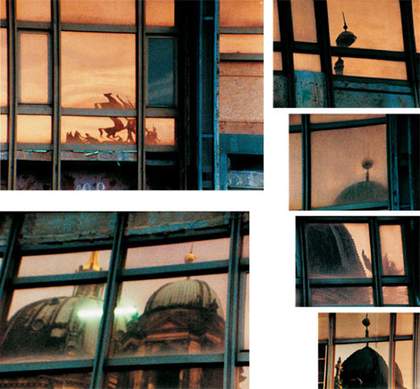The meaning of the apparent ahistoricity of drawing is determined by the other technologies of representation that co-exist with it at any given moment. This effect itself is a historical construct. Drawing becomes ‘archaic’ in the age of mechanical reproduction, yet this archaism makes contact with the tactility of the most up to date mediums. And if writing with light began by imitating drawing, as analog photography itself becomes an archaic medium, drawing will aspire to the condition of the photograph, not as a projective representation, but rather as a resemblance produced by contact.1
As art historian Michael Newman suggests, the meaning of drawing’s specific qualities is conditioned by the field of other visual technologies with which it shares a space at any one time. As verb or as noun, drawing will appear differently when considered in relation to painting or to writing, to sculpture or printmaking, to photography, film, or digital media. Indeed, it is argued here that a richer and more precise conception of drawing’s specific capacities can be arrived at by exploring its alignments with, and differences from, other forms of practice, rather than by attempting to determine the properties supposedly intrinsic to drawing in itself. Because the field of available technologies is constantly shifting, this kind of relational definition of drawing would also need to be acknowledged as historically contingent.
The more precise implication of Newman’s argument is that the impact of digital media has been so dramatic as to force into alignment existing ‘analogue’ technologies, specifically drawing and photography, which have conventionally been considered to operate very differently.2
As is frequently noted, when compared with the digital, analogue photography’s indexicality becomes newly prominent.3
We might add that film’s celluloid support, composed as it is of a linear, discontinuous sequence of internally continuous frames, also gains new visibility in a digital age. This essay explores some ways in which our conception of drawing is reconfigured by the arrival of digital media. One aspect of this is to extend the implications of Newman’s insight, and to consider drawing’s relationship with film: to explore the notion of what the poet and artist Henri Michaux called ‘cinematic drawing’.4
A second aim, however, is to exceed the specifically technological dimension of the analogue/digital opposition, and to explore the way in which this binary might also be used to specify a conception of thinking as backgrounded by the body’s liveliness and interference. That is, how concepts and processes associated with the analogue are particularly attuned to articulating the kinds of conversions involved in embodied perception, as well as the intensive or affective register of those processes. This shift in emphasis draws the discussion away somewhat from the issue of medium specificity, and towards more phenomenological questions regarding duration and embodiment, which are nevertheless crucial in thinking about the production and reception of drawings.
In this I shall focus upon the blackboard drawings of Tacita Dean, which she began making in the early 1990s, and William Kentridge’s Drawings for Projection, a series begun in 1989, and to which the most recent addition was Tide Table 2003.5
Both artists came to international prominence during the mid to late 1990s, a moment with a degree of remoteness from our own, when the Web was in its infancy and digital imaging was not yet supported by the kind of processing power that has made it the utterly pervasive and indispensable presence it is today. In the works discussed here, both artists specifically dramatise the relationship between drawing and film; both have explicitly embraced anachronistic or obsolete objects and technologies; and both have also spoken of a connection between their drawing process and particular modes of thinking.6
Analogue and digital
As media theorist Lev Manovich explains, whether built from scratch on computers or sampled from analogue sources, digital media objects are characterised by their reducibility to a uniform numerical code, to vast sequences of I/0 combinations.7
This kind of composition stands in contrast to analogue signals, which are continuous in both time and amplitude and are irreducible to a numerical form. In an analogue microphone, for example, a continuous sound wave is converted (or transduced) into an electrical signal, with each modulation in amplitude registered in a corresponding change in voltage. An analogue signal can also be translated into digital data in a process involving two steps: sampling and quantisation. Here, a continuous signal is converted into a series of discrete units, each being then assigned a numerical value. This process inevitably involves some loss of information, depending upon the frequency with which samples are taken (sampling rate) and how finely the output values are differentiated (resolution).
Together with numerical representation, Manovich asserts, the second crucial property of digital objects is that they are subject to ‘algorithmic manipulation’ and so are fully programmable.8
This is without historical precedent, and, Manovich argues, these two basic principles of new media objects – numerical representation and programmability – produce a series of second-order characteristics and operations, one of which is transcoding.9
To transcode something is to translate it from one digital format into another (as opposed to transduction, an analogue term, which refers to the conversion of one type of energy into another). This possibility is enabled by the fact that digital data is composed of the most basic differential units, to which it can be decoded, edited if desired, and then re-encoded into another output format. This enables Friedrich Kittler to announce:
The general digitalization of channels and information erases the differences among individual media. Sound and image, voice and text are reduced to surface effects, known to consumers as interface … Inside the computers themselves, everything becomes a number: quantity without image, sound, or voice. And once optical fibre networks turn formerly distinct data flows into a standardized series of digitalized numbers, any medium can be translated into any other. With numbers, everything goes. Modulation, transformation, synchronization; delay, storage, transposition; scrambling, scanning, mapping – a total media link on a digital base will erase the very concept of medium. Instead of wiring people and technologies, absolute knowledge will run as an absolute loop.10
The indifference of algorithms to medial contents or sensory fields means that, as critical theorist Mark Hansen argues, ‘the very task of deciding what medial form a given rendering shall take no longer follows from the inherent differences between media (which have become mere surface differences).’11
Digital image files such as JPEGs and TIFFs are composed of pixels, the values of which are derived from a uniform code, distributed on a pre-arrayed grid. The analogue image, by contrast, is the product of photochemical processes that do not have recourse to any such intermediate coding in their qualitative conversions of light.
Debates concerning the impact of digital media on existing visual technologies have so far centred on lens-based media. Indeed, the extraordinary new potentials for image making and image manipulation offered by digital tools have rendered analogue photography and film all but obsolete in the everyday world, with major companies discontinuing their production lines.12
With a mixture of pragmatism and poetics, Dean has protested against this annihilation of the analogue and the abandonment of its aesthetic potential: ‘We are giving up our ability to make as near as perfect [a] simulacrum of our visual world, which digital still fails to replicate despite its increasing proliferation of pixels, and we are doing so willingly.’13
One of the problems with the digital image, for Dean, is that, ‘It is too far from drawing, where photography and film have their roots: the imprint of light on emulsion, the alchemy of circumstance and chemistry, marks upon their support.’14
Indeed, ontological questions arising from the departure of the digital image from the indexical status of the photograph have been prominent in theoretical discussions of the stakes of these shifts for visual art.15
Although re-touching has long been a feature of the final preparation of analogue photographs, the ease and extent to which seamless and traceless revisions can be made to digital images, at the level of their fundamental coding, is unprecedented.16
Aside from within various exhibition spaces, conferences and publications specifically devoted to new media and digital art (for example, SIGGRAPH and Ars Electronica), drawings made using digital means are still largely absent from the landscape of major exhibitions and publications devoted to post-war practice.17
This relative invisibility takes place against a backdrop of the ubiquity of software programs such as AutoCAD (first released in 1982), which have revolutionised the world of architectural, commercial and industrial draughtsmanship. Digital drawing tools have afforded artists and designers an extraordinary array of capacities to produce, store, overlay, rework and duplicate graphic schemes. The mouse or stylus replace conventional drawing tools, and the frictionless luminosity of the computer monitor is substituted for the tactile grain of the paper sheet. Since the 1980s, digital drawing tablets have been available for the home computer. Here, a sensitised surface acts as a page, with the drawn image usually appearing on a separate monitor.18
Sensitivity to the pressure and tilt of the stylus is now very acute, and the replication of visual effects generated by different brushes, pencils, crayons and erasers extremely sophisticated.
The relative invisibility of digital drawing in a visual art context suggests that, despite numerous claims for the waning of the aura of the art work since Walter Benjamin’s famous (and ambivalent) essays of the 1930s, a fascination remains with drawing’s tracing of the singular, finite activity of its own making.19
While the expressive doxa that drawings provide access to the artist’s inner being have not survived the practical and theoretical onslaughts it has sustained since the 1960s, it remains apparent that the drawn mark does evidence the process of its making with particular immediacy.20
What claims can legitimately be made for the meaning of that bodily residue is an open question, but, at least since the invention of the printing presses, the idea of the authentic corporeal trace has remained important to the phenomenological encounter with drawing, even if the dominant emphasis, at least since the 1960s, has shifted away from the conveyance of expressive contents and towards the more literal elaboration of systems, signs and processes.21
This involvement of the body in the production of drawings nevertheless implies a responsive relationship with conscious intentions or unconscious processes of the artist, and contrasts both with the production of most photographs, which tends to actively bypass the interference of the maker’s body, and with the numerical mediations involved in digital images.
Together with its changed relationship to the body, digital drawing also involves a movement away from the material heterogeneity common to ‘manual’ drawing practices. When compared with painting or sculpture, drawing would hardly be thought of as dramatising its materiality; indeed, as French art historian Henri Focillon wrote in the 1930s, ‘[Drawing involves] a process of abstraction so extreme and so pure that matter is reduced to a mere armature of the slenderest possible sort, and is, indeed, very nearly volatised.’ However, Focillon continues, ‘matter in this volatile state is still matter … Its variety, moreover, is extreme: ink, wash, lead pencil, charcoal, red chalk, crayon, whether singly or in combination, all constitute so many distinct traits, so many distinct languages.’22
In light of drawings by Joseph Beuys, Ed Ruscha or Cornelia Parker, for example, Focillon’s list is in need of radical extension, but the way in which drawing foregrounds the variety, contingency and fragility of its material constitution continues to be crucial to its effects. In its slightness, drawing’s materiality can become more rather than less powerful: from the flickering miasma of Georges Seurat’s black conté chalks on Michallet paper, to the truant bleed of Henri Michaux’s supple, inky glyphs, to the delicate activation of Agnes Martin’s infinitesimally differentiated grids.23
Drawing’s precise engagement with a material spectrum of liquidity and dryness, frangibility and obduracy, porosity and impermeability, remains a vital source of its power, foiled as it is by the ubiquity of everyday interactions with the durable plastics of computer hardware. Moreover, the materiality of drawing is not only important to the mark as it is inscribed, but also as it is removed. In the process of writing or drawing on a computer, it is very easy to delete a pixel or character, instantly removing it from view.24
Erasure works differently, and it is impossible to actively erase a material mark without some effort or residue. Both Dean and Kentridge dramatise this work of erasure, the insistent visibility of which announces their shared attachment to the temporality, materiality and bodily investments made newly visible in ‘analogue’ drawing by the arrival of the digital.
Cinematic drawing
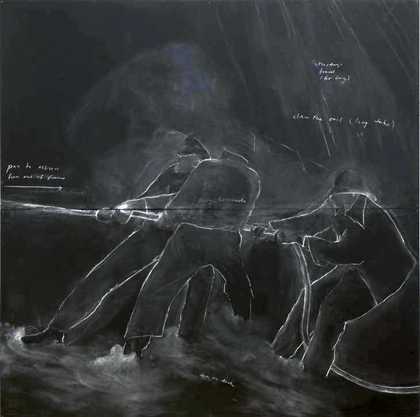
Fig.1
Tacita Dean
The Roaring Forties: Seven Boards in Seven Days (Board 2) 1997
Tate
© Tacita Dean, courtesy Frith Street Gallery, London and Marian Goodman Gallery, New York/Paris
Tacita Dean’s The Roaring Forties: Seven Boards in Seven Days 1997 (figs.1–2) is composed of seven eight-foot-square blackboard panels bearing white chalk drawings and fragments of written script. They describe the progress of a sea adventure, complete with raging storms, an imperilled crew and an eventual homecoming. The sequence begins with a minimally worked panel, annotated with a title at the top: ‘Roaring Forties – an epic C19 sea movie’, as well as some initial filmic cues: ‘fade up from black’, ‘start’. The second board shows a crew of sailors clewing the sail (‘long take’); in the third, the presence of a gliding albatross warns of what is to come: in the next two boards the vessel and its crew are in trouble, thrown and listing amidst a howling gale. By the sixth board, a close-up of the swell with no horizon, the storm has subsided, and the seventh and last board offers a happy ending as the surviving sailors row into frame and towards dry land.
As its full title suggests, the series was made over seven days, with Dean working in situ at The Drawing Center in New York. The blackboards retain the foggy traces of erased and re-worked passages, particularly evident in Boards II and VI.25
The chalk sometimes dissolves into a grey mist, and at others trails the outline of forms like a running current. The visible work of erasure further foregrounds the performative dimension of the drawings, with the time and labour of their making openly exhibited on the surface of each board. These unstable drawn images interact with clusters of short text fragments, which offer directions for imaginary camera angles (‘close up on swell’, BD6), special effects (‘fx wind’, BD4), atmospheric conditions (‘wind abates’, BD5, ‘full sunlight’, BD7), exclamations (‘man overboard’, BD5, ‘land ahoy’, BD7), extra descriptive details (‘capable hands’, BD4) and narrative progress (‘she’s still afloat (just)’, BD5).
The Roaring Forties takes its place within a series of blackboard works by Dean relating to the sea.26
The artist has made explicit the connection between these drawings and the instability of their subject, the driest of materials proving the perfect vehicle for conveying the sea’s liquid dynamism: ‘The flux, the drawing and the redrawing, the erasure and the rubbing out belong to the sea, and nothing else has that same flux. I need that for working with the chalk. The drawings can’t be fixed because it would take the chalk off. They are a kind of performance.’27
In the midst of a fog of erasures in BD2, Dean has written, half-erased, the words ‘Sorry Leonardo’. This apology in fact refers to Dean’s erasure of an image of a ship drawn by New York artist Leonardo Drew, which is still visible above and to the left.28
However, given the emphasis in the work upon process and movement, and indeed upon the dynamics of water, the name Leonardo cannot help but evoke the celebrated Renaissance polymath, whose corpus of drawings was crucial in establishing a new relationship between drawing, indeterminacy and the movements of the mind.29
The Roaring Forties refers to a zone in the southern Atlantic, between 40° and 50° latitude, infamous for its treacherous winds. The drawings were made at the beginning of 1997, just a few months after Dean completed her breakthrough film, Disappearance at Sea (1996), which she famously related to the ill-fated sea voyage of amateur sailor Donald Crowhurst.30
Shot at dusk at Berwick Lighthouse in Northumberland, the film moves between close-up footage of the rotating lighthouse lamp, and broader views of the sea, cliffs and setting sun. The opening sections are dominated by the hypnotic rotations of the lamp’s clanking machinery and the chromatic intensity of the sunset. As darkness descends, the bulb is illuminated and projects its rays into the night. In the slow final shots, the sense of fragility and isolation is palpable, as the beam is all but smothered by the gathering darkness. Metaphorical connections with Crowhurst’s precarious mental state seem inevitable. The film closes with a finger of light cutting through the blackness with a slight, glancing beam, which barely picks out details of the rocky cliffs and the shifting surface of the night sea.31
The May 2006 display of Dean’s works at Tate Modern offered a suggestive juxtaposition of The Roaring Forties with Disappearance at Sea. Walking out of the darkened room in which the film was installed and into the neighbouring space with these cinematic blackboards, it was difficult to avoid the rhyme between that fragile beam of light projected into the night and the white chalk marks which emerge from their black ground.
At 2400 x 2400 mm each, the impressive scale of the blackboards invites comparison with the cinematic screen, immediately distancing them from the connotations of privacy and modesty with which drawing’s more conventionally intimate proportions are frequently associated. Dean herself has made explicit the connection between her blackboard drawings and cinematic forms, describing them as ‘dysfunctional storyboards’.32
Although not exhibited in the order in which they were produced, the seven boards come to make sense as a series: narrative action is implied between each board, in the gaps, and the written directions signal various atmospheric conditions and instructions for how the depicted action might be articulated in film.33
In BD4, for example, as six sailors are hauled over a mast gathering in the sails, instructions are left for a cameraman, signalling various actions and effects: ‘ACTION – out on the yard,’ ‘zoom in expression of fear,’ ‘look yonder (out of frame),’ ‘fx wind.’ A curved arrow with the words ‘to and fro’ indicates the movement of the mast as it sways in the wind. These written cues invite the viewer’s imagination to animate the image, producing an array of internally enacted zooms, pans and sound effects.
Dean herself has commented: ‘These huge wreckings, that scenery, they are not really related to films that I might make, but it’s in order to give the impression that these are films already. Somehow, they are films.’34
In a recent essay, art historian Pavle Levi has theorised a form of practice that he names ‘cinema by other means’, and describes as ‘the practice of positing cinema as a system of relations directly inspired by the workings of the film apparatus, but evoked through the material and technological properties of the originally non-filmic media’.35
This mode of practice, for Levi, can invest static objects with ‘a creative potential to generate an entire set of kinetic, film-like effects’.36
Levi’s concept is certainly helpful in thinking about Dean’s blackboards, which notably involve a much more complex range of cinematic techniques than are found in her celluloid films which are generally composed of lengthy, locked-off static shots, devoid of any such zooms, pans or dissolves.
Opening a 2001 essay on Dean’s work, Michael Newman asserts that ‘The mediums of art are concretions of time’, with each medium and each art work serving to ‘delay, condense and spread out time in their own way.’37
The temporal structure of The Roaring Forties is complex. The boards evidence the time of their making, whilst also re-shuffling the chronology of that process; they constitute static objects, but it is also hardly possible to resist animating them while we look, given the many and varied cues provided by the artist. Dean has herself commented that these boards fuse the conventions of the storyboard with those of the production still: both the before and the after of the cinematic event.38
This amounts to a complex interplay of movement and stasis, continuity and rupture, material facticity and imaginative projection, pairs of terms that are also characteristic of the operations of film (‘cinematograph’ itself meaning the writing or drawing of movement).
As a ‘concretion of time’, we could assert that there is something cinematic about the very structure of drawing itself. Celluloid film is composed of a linear sequence of discrete but continuous photographic stills, which are passed through the projection apparatus to give an illusion of movement, the eye filling in the infinitesimal gaps between frames. Each frame is an index of a moment in time, automatically registering the fall of light across its surface, a field which will therefore include a host of contingent and unintended details. Drawings, too, are composed of a series of indexical traces, sometimes remaining discrete and sometimes not. Each drawn mark, whatever else it also does, refers to a passage of activity, and these traces then combine on a single surface to produce an image whose reception happens in time and involves movement, although that movement of course belongs to the eye and mind of the viewer rather than the mechanical projection apparatus. This is a slow cinema, however, as the length of time for which the drawn surface is ‘exposed’ to an inscriptive force extends well beyond the flicker of an instant. Likewise, the gaps between marks are also dilated and indeterminate. Just as the issue of chance and contingency is important in the production of analogue photographs, unfastening the resulting image from absolute authorial intention, so the unruliness of both the maker’s body and of the drawing materials constitutes a zone of interference which likewise complicates the drawn mark’s relationship with the more weightless mobilities of thought. Drawing couples the actively willed with the passively received, the intentionally directed with the non-conscious desires of the hand.39
The temporal gap between each mark constitutes a realm of silent bodily deliberations that subtends a drawing’s visible residues. Writing in 1952, French philosopher Maurice Merleau-Ponty, having just considered the wavering and wandering of Matisse’s hand as it was revealed in a section of slow-motion film footage, wrote of the necessity of attending to ‘the threads of silence that speech is mixed together with.’40 Matisse referred to the pure line drawings which dominate his Thèmes et variations (1941–2) as ‘the cinema of my sensibility’.41 The drawn marks, which he described as ‘plastic writing,’42 activate the white space of the page to produce what art historian John Elderfield referred to as ‘flashing frames of light’.43 In 1939 Matisse wrote, ‘My line drawing is the purest and most direct translation of my emotion … [W]hich should speak without clumsiness, directly to the mind of the spectator.’44 Both Matisse’s emphasis on the achievement of the single lightning stroke and his expressive rhetoric are a long way away from the priorities of much contemporary drawing. However, Merleau-Ponty’s attention to the ‘threads of silence’ with which utterances are woven together is worth pursuing in relation to drawing’s particular form of ‘cinema by other means’. Such attention would encourage an exploration of the drawing process, and specifically of what happens in the temporal gaps between strokes. The working practice of William Kentridge is particularly suggestive in this regard.
Fortuna and process
Working to find a visual language with which to meaningfully reckon with the political, social and psychological consequences of South Africa’s apartheid regime and its demise, Kentridge developed a new assemblage of formal and technical means which marries drawing and film very explicitly. His Drawings for Projection should not be dissociated from his struggle to negotiate a position in relation to the ‘immovable rock’ of apartheid, although in this short discussion I can examine just some aspects of his work which bear upon the question of drawing’s relationship to film, to digital media, and to particular modes of thinking.45
To start work on a drawing, a sheet of paper is tacked up on the studio wall, while halfway across the room the artist stations his Bolex or Ariflex camera. Kentridge begins drawing with a stick of charcoal and at intervals walks to his film camera, shoots one or two frames, then returns to the drawing; he makes marginal erasures, re-photographs and then redraws. Contrasting with CEL animation, then, each shot of the film charts the unfolding of a single drawing, and the final works, each the result of several months’ work, last between four and nine minutes. It is in the process of moving back and forth, which Kentridge describes as ‘stalking the drawing’, that a kind of objective chance takes hold, which Kentridge has named fortuna.46
Whereas to produce a traditional animation, a studio needs to work out the content of the film fully in advance, Kentridge describes fortuna as a contingent and transformative agency that guides him from one sequence to the next, enabling the development of visual ideas that were not (and perhaps could not have been) planned in advance; it is ‘something other than cold statistical chance, and something too outside the range of rational control’.47
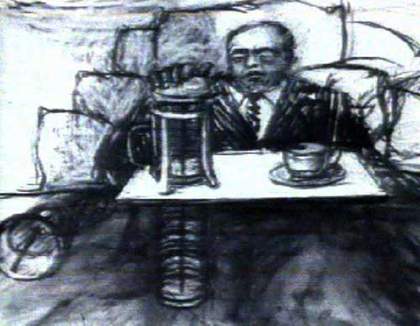
Fig.3
William Kentridge
Mine 1991
Tate
© William Kentridge
One example Kentridge provides arose while he was working on Mine 1991 (fig.3).48 The problem was how to move from the mine owner Soho Eckstein having breakfast in bed to his workers descending into a mineshaft. In Kentridge’s studio that day there was a cafetière (it could easily have been a teapot, he remarks), and he began to draw the descent of the plunger, drawing, erasing and re-drawing the dark column a little further down. It was only in this act of drawing that he realised the correspondence between the cafetière’s plunger and the vertical drop of the mine shaft: ‘The sensation was more of discovery than invention. There was no feeling of what a good idea I had had, rather, relief at not having overlooked what was in front of me.’49 The artist adopts a receptive position as unforeseen solutions to aesthetic and narrative problems are presented by the contingency of circumstance and the ‘interference’ of material process, which encourage what art historian Barbara Maria Stafford has called ‘nonformalizable moments of flexible insight’.50 Just as Merleau-Ponty discussed the artist’s hand as working ‘like a weaver on the wrong side of his material’, constructing previously informulable sets of conditions in its labour of executing ‘this painting which did not yet exist’, Kentridge’s working process similarly involved bodily and imaginative wanderings which keep the work open to indeterminate becomings.51 Indeed, for him ‘This reliance on fortuna in the making of images or texts mirrors some of the ways we exist in the world even outside the realm of images and texts.’52
The thick of material process sustains this generative openness in Kentridge’s practice, and the artist frequently makes reference to the specificity of his materials: ‘The scale of the drawings (the largest are an arm’s span, the smallest about a quarter of that), the materials (charcoal, one or two pastels, an eraser, and a cloth of chamois leather), and the format (film, not 4:3 video) stay the same.’53
Elsewhere, Kentridge has said, ‘I also like charcoal because of the indeterminacy of the point. I use a fairly heavy piece of charcoal, about one and a half inches in diameter. It’s like holding a small object rather than a long, thin point, and you have to trust that your hand, wrist, and arm can guide the edges of it as you draw. The crudeness of it is important for me.’54
The activity of drawing and erasing, punctuated by repeated shuttlings between page and camera, is responsive to the permissions and constraints of his specific materials, which ground the ductile moves of the imagination:
Walking, thinking, stalking the image … It is not so much a period of planning as a time of allowing the ideas surrounding the project to percolate. A space for many different trajectories of an image, where sequences can suggest themselves, to be tested as internal projections. This pacing is often in relation to the sheet of paper waiting on the wall. As if the physical presence of the paper is necessary for the internal projections to seem realizable. The physical size and material enforce a scale, a particular starting point, a composition. The myriad of possibilities is called to order.55
For art historian Rosalind Krauss, this assemblage of methods and materials constitutes the invention of a new medium, or automatism, which for her is another kind of ‘calling to order’, a way to organise the results of the artist’s ‘taking and seizing of chance’ into a coherent framework: ‘the discovery of a form – call it a convention – that will generate a continuing set of new instances, spinning them out the way a language does’.56 Using the language of Danish linguist Louis Hjelmslev, Krauss describes the resonance between the ‘form of expression’ of Kentridge’s work, which is based upon a model of drawing as palimpsest, and the ‘form of content’, which has to do with the array of obsolete technological objects the artist represents, and the range of older graphic styles – from Goya to Beckmann – that Kentridge uses to invoke an era ‘in which political image-making seemed so much less fraught’.57 The historical consciousness embedded in this new medium, then, for Krauss, secures Kentridge’s improvisations against the dissipative effects of installation art and digital media on meaningful criteria for gauging the value of artistic contributions.58 For Krauss, the ‘stone age film-making’ described above offers resistance to ‘techno-teleologists’ such as Friedrich Kittler, who regard the annihilation of differences between mediums by the digital as inevitable.59 For her, this constitutes a Benjaminian attempt to retrieve something of the potential of older technologies on the eve of their disappearance, and, in so doing, ‘to undermine a certain kind of spectacularisation of memory’.60
Kentridge articulates the way in which his techniques oppose the logic of digital media in a related way, although one which departs from Krauss’s formalist account in important respects:
There is something about the act of drawing that reflects the process of labour … It is the appearance of work, making visible the hours on the paper. In an era in which the human labour in everything was clear, there was something utopian in making art appear effortless or at least miraculous. Now that we take the impossible for granted – digital animation, Photoshop (the invisible workings of a computer compared to the very visible and audible mechanics of a typewriter) – there seems a place for showing physical process. (And through this mental process; this is not clear, but some impulse in this direction sits in my guts – not that they are to be trusted either.)61
Kentridge’s celebration of the relatively unconstrained labours of the artist in the studio might be challenged by an avant-garde programme demanding the artist’s internalisation of and alignment with the forms of de-skilled productive labour, made routine, which surround and maintain the conditions in which art must operate.62
For Kentridge, however, the demonstration of artistic labour bears upon conditions specific to South Africa, rather than upon forms of capitalist exploitation in general:
To glide above [the demonstration of the agency of labour], working only the realm of the conceptual, using hired hands to do the actual labour has been tainted here, or made impossible by the image of the white overseer in his shorts in the shade, watching a gang of labourers doing the work. Not to say that this is necessarily an accurate image, and even though labour is less visible in Western Europe and North America, I do understand it is still there – but the image and its shame are more present here.63
Art is maintained, at least at the level of process, as a space of relative freedom and improvisation, but one which gets its meaningful bearings from wider social conditions.
Drawing, thinking and the analogue
Perhaps mindful of rehearsing problematic claims regarding the kind of access drawing provides to the artist’s inner life, Kentridge is understandably tentative in asserting the specific connection between his marks and his thought. Nevertheless, he does frequently maintain a link, referring to drawing as ‘a slow-motion version of thought’,64 and to his studio as ‘like an enlarged head’.65 Dean also affirms a connection: ‘Thinking too becomes analogue when it is materialised into a concrete form; when it is transmuted into lines on paper or marks on a board. It is as if my frame of mind is analogue when I draw’.66 What, then, might it mean to be in an ‘analogue frame of mind’, or to see mental operations from the point of view of the analogue/digital binary?
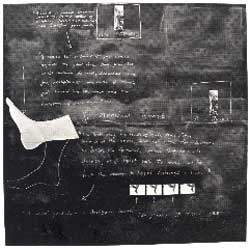
Fig.4
Tacita Dean
Sixteen Blackboards (Board 3) 1992
Sixteen parts, photograph on paper
50 x 500 mm each
© Tacita Dean, courtesy Frith Street Gallery, London and Marian Goodman Gallery, New York/Paris
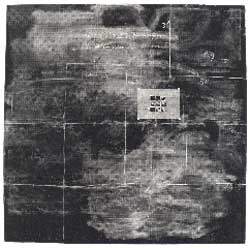
Fig.5
Tacita Dean
Sixteen Blackboards (Board 14) 1992
Sixteen parts, photograph on paper
50 x 500 mm each
© Tacita Dean, courtesy Frith Street Gallery, London and Marian Goodman Gallery, New York/Paris
Long thought lost and only rediscovered in a London storeroom in 2004, Dean’s Sixteen Blackboards 1992 (figs.4–5), engages directly with the relationship between drawing, thinking and analogue media. The work consists of a series of sixteen photographs (each 50 x 50cm) of a single blackboard, taken by the artist over a period of weeks whilst studying at the Slade in 1991 (the exact timing of each photograph and the length of the intervals between shots were not recorded). The photographs offer a fragmentary record of a working studio tool, the panel having functioned as a screen for the projection of thought, indexed in the form of sketches, diagrams and notes, rapidly set down and soon rubbed away. Rather than charting the progress of a single project, Sixteen Blackboards witnesses the emergence, recession and sometimes cohabitation of several lines of enquiry emerging simultaneously. While many images clearly relate to specific films made by Dean, many drawings and notes remain unanchored from particular works realised in film.67
Like thoughts and memories, these various markings have unequal life spans: some details arrive in one image only to reappear scrubbed out in the next; others outlive the notes or images that initially provided their framing context by several boards; still others are only ever present as smudges: thoughts receding too quickly to be registered. The introduction of collaged elements, complete upon arrival and removed with no residue, foils this cloudy texture of inscription and unbecoming.
The use of the blackboard as an artistic device evokes the examples of Cy Twombly and Joseph Beuys, two important artists for Dean.68
For Beuys, the blackboard took on a performative and pedagogical function proper to its more familiar role in the classroom. Beuys harnessed his enormous corpus of drawings very closely to the development of his thinking, which he also conceived of in plastic terms, as if somehow already sculptural:
Drawing is … the first visible thing of the form of the thought, the changing point from the invisible powers to the visible thing … It’s really a special kind of thought, brought down onto a surface, be it flat or be it rounded, be it a solid support like a blackboard or be it a flexible thing like paper or leather or parchment, or whatever kind of surface … It is not only a description of the thought … You have also incorporated the senses … the sense of balance, the sense of vision, the sense of audition, the sense of touch.69
While much of Beuys’s rhetoric can now seem outmoded or quixotic, the way in which he conceived of drawing’s relationship with thought, materiality and embodiment remains suggestive. Krauss wrote of Kentridge’s drawings that: ‘There is a sense in which the body’s rhythms have penetrated [their] support, to slow it down, to thicken it, to give it density.’70 This density is palpable in Sixteen Blackboards too, with thinking presented not as the processing of a weightless, frictionless code, like Kittler’s ‘absolute knowledge’ running ‘as an absolute loop,’71 but rather as thought caught up in the body’s purchase and interference, as thought felt. As Canadian theorist Brian Massumi has argued:
There is no thought that is not accompanied by a physical sensation of effort or agitation (if only a knitting of the brows, a pursing of the lips, or a quickening of the heartbeat). This sensation, which may be muscular (proprioceptive), tactile, or visceral is backgrounded. This doesn’t mean that it disappears into the background. It means that it appears as a background against which the conscious thought stands out: its felt environment.72
Departing from conceptions of mental activity which take the digital computer as their model, Massumi argues that this activity should also be conceived in terms of analogue operations: ‘The processing may be digital – but the analog is the process.’73 While the digital deals exclusively in quantitative terms, thinking, he argues, has an irreducible qualitative dimension; he elaborates using the example of word processing: ‘What is processed inside the computer is code, not words. The words appear on screen, in being read. Reading is the qualitative transformation of alphabetical figures into figures of speech and thought. This is an analogue process.’74 To be anything other than a meaningless intangible abstraction, the digital must ‘circuit into the analogue.’75 This happens in a kind of enframing done by the subject as it encounters stimuli; the body acts as a kind of transducer, converting one signal into a qualitatively different form:
[The analogue is a] continuously variable impulse or momentum that can cross from one qualitatively different medium into another. Like electricity into sound waves. Or heat into pain. Or light waves into vision. Or vision into imagination … Or outside coming in. Variable continuity across the qualitatively different: continuity of transformation.76
This conception of the embodied mind’s enframing of incoming stimuli bears importantly upon the question of the reception of art works. To pursue this might be to shift emphasis from the registration of thought in the act of making, towards a consideration of the way in which the object is de-actualised in thought upon reception.77 Certainly, the aesthetic coherence and potency of the work of both Dean and Kentridge could be accommodated into such a discussion. This might serve to counter the affective atmosphere of nostalgia that often pervades a consideration of the attachment to the analogue in a digital age, by directing the purchase of the term analogue to the liveliness generated at the interface of artworks and bodies rather than to a given set of visual technologies only. Finally, the category of drawing, too, may be seen as re-energised as it enters into transformative relation with the other visual technologies with which it shares space; and in maintaining contact with these new forms, the qualities and capacities of existing modes of drawing are given new visibility and purchase.

